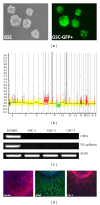Tumor and endothelial cell hybrids participate in glioblastoma vasculature
- PMID: 24868550
- PMCID: PMC4017715
- DOI: 10.1155/2014/827327
Tumor and endothelial cell hybrids participate in glioblastoma vasculature
Abstract
Background: Recently antiangiogenic therapy with bevacizumab has shown a high but transient efficacy in glioblastoma (GBM). Indeed, GBM is one of the most angiogenic human tumors and endothelial proliferation is a hallmark of the disease. We therefore hypothesized that tumor cells may participate in endothelial proliferation of GBM.
Materials and methods: We used EGFR FISH Probe to detect EGFR amplification and anti-CD31, CD105, VE-cadherin, and vWF to identify endothelial cells. Endothelial and GBM cells were grown separately, labeled with GFP and DsRed lentiviruses, and then cocultured with or without contact.
Results: In a subset of GBM tissues, we found that several tumor endothelial cells carry EGFR amplification, characteristic of GBM tumor cells. This observation was reproduced in vitro: when tumor stem cells derived from GBM were grown in the presence of human endothelial cells, a fraction of them acquired endothelial markers (CD31, CD105, VE-cadherin, and vWF). By transduction with GFP and DsRed expressing lentiviral vectors, we demonstrate that this phenomenon is due to cell fusion and not transdifferentiation.
Conclusion: A fraction of GBM stem cells thus has the capacity to fuse with endothelial cells and the resulting hybrids may participate in tumor microvascular proliferation and in treatment resistance.
Figures




References
-
- Vredenburgh JJ, Desjardins A, Herndon JE, II, et al. Phase II trial of bevacizumab and irinotecan in recurrent malignant glioma. Clinical Cancer Research. 2007;13(4):1253–1259. - PubMed
-
- McDonald DM, Choyke PL. Imaging of angiogenesis: from microscope to clinic. Nature Medicine. 2003;9(6):713–725. - PubMed
-
- Mollica F, Jain RK, Netti PA. A model for temporal heterogeneities of tumor blood flow. Microvascular Research. 2003;65(1):56–60. - PubMed
Publication types
MeSH terms
Substances
LinkOut - more resources
Full Text Sources
Other Literature Sources
Medical
Research Materials
Miscellaneous

